Serving 186 students in grades 6-8, Manhattan 6-8 ranks in the top 50% of all schools in Montana for overall test scores (math proficiency is top 50%, and reading proficiency is top 50%).
The percentage of students achieving proficiency in math is 48% (which is higher than the Montana state average of 35%). The percentage of students achieving proficiency in reading/language arts is 53% (which is higher than the Montana state average of 46%).
The student:teacher ratio of 16:1 is higher than the Montana state level of 12:1.
Minority enrollment is 4% of the student body (majority Hispanic), which is lower than the Montana state average of 23% (majority American Indian).
Quick Stats (2025)
- Grades: 6-8
- Enrollment: 186 students
- Student:Teacher Ratio: 16:1
- Minority Enrollment: 4%
- Overall Testing Rank: Top 50% in MT
- Math Proficiency: 48% (Top 50%)
- Reading Proficiency: 53% (Top 30%)
- Science Proficiency: 45-49% (Btm 50%)
- Source: National Center for Education Statistics (NCES), MT Dept. of Education
School Overview
Manhattan 6-8's student population of 186 students has declined by 17% over five school years.
The teacher population of 12 teachers has declined by 14% over five school years.
Grades Offered
Grades 6-8
(No virtual instruction)
(No virtual instruction)
Total Students
186 students
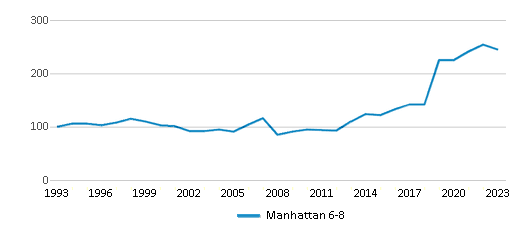
Gender %
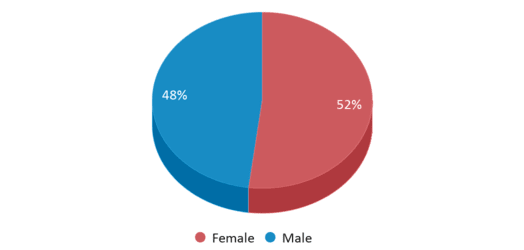
Total Classroom Teachers
12 teachers
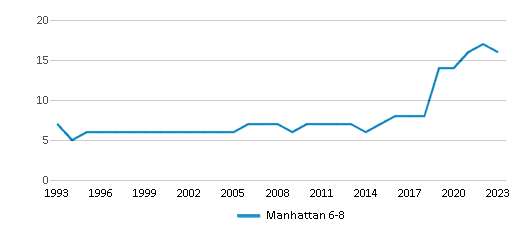
Students by Grade
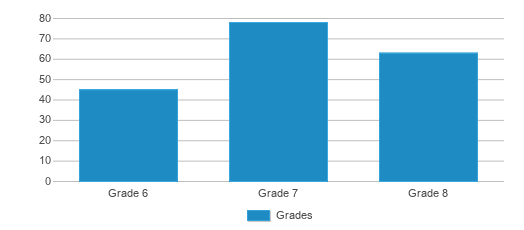
School Rankings
Manhattan 6-8 ranks within the top 50% of all 722 schools in Montana (based off of combined math and reading proficiency testing data).
The diversity score of Manhattan 6-8 is 0.08, which is less than the diversity score at state average of 0.40. The school's diversity has stayed relatively flat over five school years.
Overall Testing Rank
#268 out of 722 schools
(Top 50%)
(Top 50%)
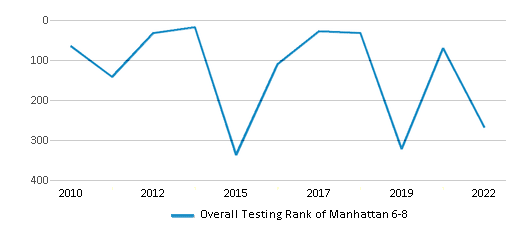
Math Test Scores (% Proficient)
48%
35%

Reading/Language Arts Test Scores (% Proficient)
53%
46%
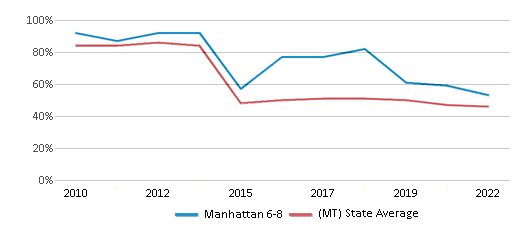
Science Test Scores (% Proficient)
45-49%
37%
Student : Teacher Ratio
16:1
12:1
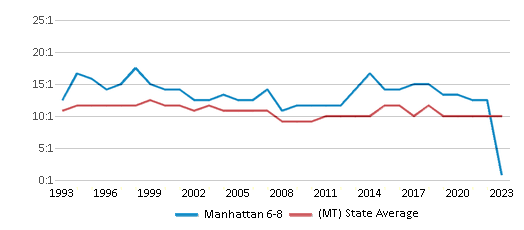
American Indian
n/a
10%
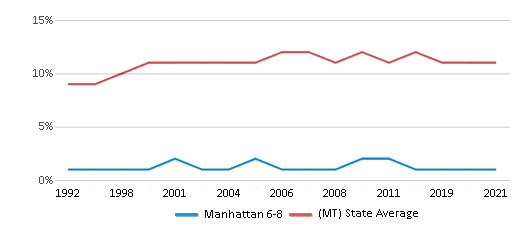
Asian
n/a
1%

Hispanic
2%
6%
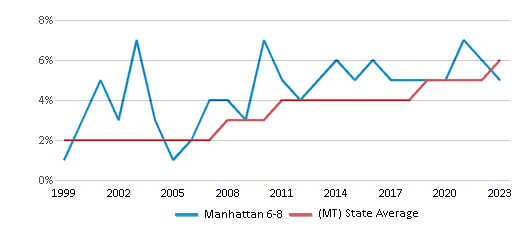
Black
n/a
1%

White
96%
77%

Hawaiian
n/a
n/a
Two or more races
2%
5%
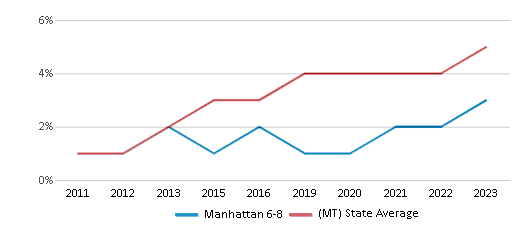
All Ethnic Groups
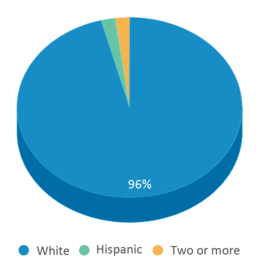
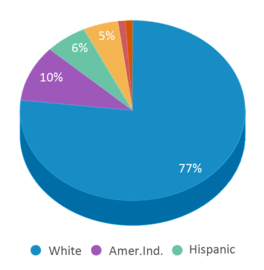

Participates in the National School Lunch Program (NSLP)
Yes
Eligible for Free Lunch
20%
42%

Eligible for Reduced Lunch
8%
5%

School Statewide Testing
School District Name
Source: National Center for Education Statistics (NCES), MT Dept. of Education
Profile last updated: 02/09/2025
Frequently Asked Questions
What is Manhattan 6-8's ranking?
Manhattan 6-8 is ranked #268 out of 722 schools, which ranks it among the top 50% of public schools in Montana.
What schools are Manhattan 6-8 often compared to?
Manhattan 6-8is often viewed alongside schools like Anderson 7-8 by visitors of our site.
What percent of students have achieved state testing proficiency in math and reading?
48% of students have achieved math proficiency (compared to the 35% MT state average), while 53% of students have achieved reading proficiency (compared to the 46% MT state average).
How many students attend Manhattan 6-8?
186 students attend Manhattan 6-8.
What is the racial composition of the student body?
96% of Manhattan 6-8 students are White, 2% of students are Hispanic, and 2% of students are Two or more races.
What is the student:teacher ratio of Manhattan 6-8?
Manhattan 6-8 has a student ration of 16:1, which is higher than the Montana state average of 12:1.
What grades does Manhattan 6-8 offer ?
Manhattan 6-8 offers enrollment in grades 6-8 (No virtual instruction).
What school district is Manhattan 6-8 part of?
Manhattan 6-8 is part of Manhattan School District.
School Reviews
Review Manhattan 6-8. Reviews should be a few sentences in length. Please include any comments on:
- Quality of academic programs, teachers, and facilities
- Availability of music, art, sports and other extracurricular activities
Recent Articles
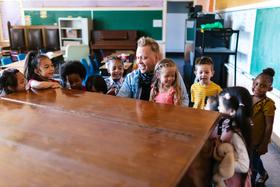
Maryland Schools: Overcrowding In Baltimore County Schools
Success breeds more students, but the additional students in some Baltimore County Schools are creating quite a challenge for the teachers and administrators at the schools. We examine the growing problem of school growth and plans the district could implement to stop it.

Longer School Days Coming for Thousands of Students Next Year
Five states will begin experimenting with longer school days next year, as part of a project to improve the quality of education in the U.S.

Knowledge is Power Program: A Strong Model for ÎÛÎÛÂþ» Schools
As many traditional public schools struggle to close the achievement gap, Knowledge is Power Program schools seem to have the right formula for helping poverty-stricken and minority students achieve success. In this article, we examine how KIPP schools are making their sThis piece explores the Knowledge is Power Program (KIPP), a network of charter schools known for its success in improving academic outcomes for underserved students. It outlines KIPP's educational philosophy, teaching methods, and the program's impact on student achievement and college readiness.





